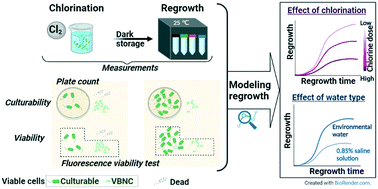Regrowth of Escherichia coli in environmental waters after chlorine disinfection: shifts in viability and culturability†
Abstract
Bacterial regrowth after water/wastewater disinfection poses severe risks to public health. However, regrowth studies under realistic water conditions that might critically affect bacterial regrowth are scarce. This study aimed to assess for the first time the regrowth of Escherichia coli (E. coli) in terms of its viability and culturability in environmental waters after chlorine disinfection, which is the most widely used disinfection method. Post-chlorination regrowth tests were conducted in 1) standard 0.85% NaCl solution, 2) river water receiving domestic wastewater effluents, and 3) river water that is fully recharged by domestic wastewater effluents. The multiplex detection of plate count and fluorescence-based viability test was adopted to quantify the culturable and viable E. coli to monitor the regrowth process. The results confirmed that chlorine treatment (0.2, 0.5 and 1.0 mg L−1 initial free chlorine) induced more than 99.95% of E. coli to enter a viable but non-culturable (VBNC) state and the reactivation of VBNC E. coli is presumably the major process of the regrowth. A second-order regrowth model well described the temporal shift of the survival ratio of culturable E. coli after the chlorination (R2: 0.73–1.00). The model application also revealed that the increase in initial chlorine concentration and chlorine dose limited the maximum regrowth rate and the maximum survival ratio, and the regrowth rate and percentage also changed with the water type. This study gives a better understanding of the potential regrowth after chlorine disinfection and highlights the need for investigating the detailed relation of the regrowth to environmental conditions such as major components of water matrices.



 Please wait while we load your content...
Please wait while we load your content...